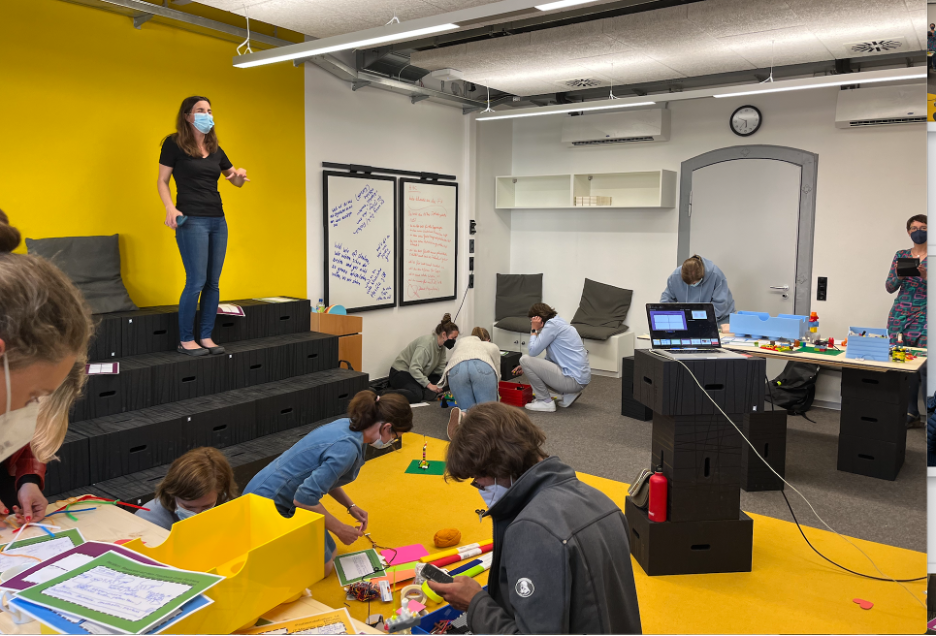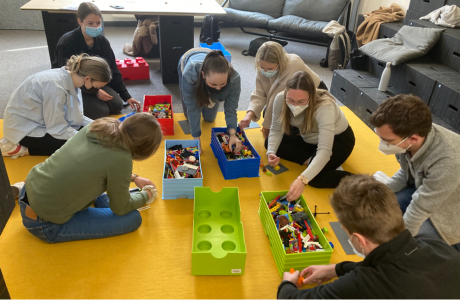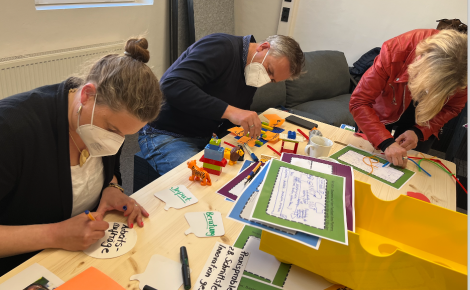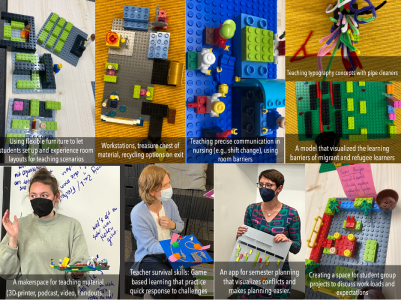Design Thinking, Maker Mindsets & Serious Play: Bringing Innovative Furniture to Life

4 days, 22 hours, three formats, 30 participants, 1000 LEGO bricks: Students, faculty, vocational education experts and teaching methodology specialists engaged in a series of workshops end of April 2022 that tapped into maker mindset, design thinking and serious play. Participants developed pedagogical ideas for using a new teaching space with flexible furniture at Münster University of Applied Science as well as innovative pedagogies for ‘Vocational Education and Training’ (VET). On Wednesday and Thursday faculty and staff from the Münster School of Vocational Education (German: Institut für Berufliche Lehrerbildung) and the Wandelwerk – Centre for Quality Assurance and Enhancement at FH Münster worked together on teaching scenarios. On Friday and Saturday, an interdisciplinary group of VET students focused on deliberate room settings and teaching skills for vocational training.
The blog post shares content and discussion topics, workshop prompts and selected results.
Workshop Topics
Maker Mindsets
The use of makerspaces in education has grown over the last decade as public awareness of the maker movement has increased. Makerspaces are collective places that facilitate design and prototyping for individuals and groups by offering access to technical equipment and material as well as expertise, guidance and training. The shared workspace allows engineers, designers, scientists, students, and hobbyists to create, fabricate, tinker and bring their ideas to life. How does this impact vocational education? We discussed implications in two settings:
- Future VET teachers need robust and flexible teaching strategies, a willingness to experiment and improve, combined with sustained resilience to succeed in their profession. In short: VET teachers profit from maker mindsets.
- Vocational schools come with built-in makerspaces as part of the practical skills training settings. However, interdisciplinary use and skill building outside of the individual student’s comfort zone is a new frontier for vocational training. Maker pedagogy has the potential to shift attitudes of learners who have an adversarial attitude towards traditional classroom learning.
LEGO Serious Play (LSP)
The Münster teacher makerspace is very well equipped with LEGO serious play brick collections, so we specifically included exercises and discussion on serious play. The facilitation method was first developed in the 1990s, when Kirk Kristiansen, the chief executive officer of the LEGO company, noticed that LEGO was spending considerable resources on external consultants to inform strategic planning. However, the people who know the most about any organization are the people who work there. Kristiansen believed that the answer was in the room, but the people didn’t have the right tools to get to it. This led to the development of LEGO Serious Play as a facilitation method. In 2010 the method became open source, and thus accessible to a wide range of trainers and educators. We discussed LEGO models as ice breakers, models of interaction, and a way of thinking with your hands.
Design Thinking
Design thinking is a practice and mindset that can be helpful to educators when addressing wicked problems. What are wicked problems? The term was coined in the 1970s by planners who realized that the problems they were addressing were beyond complex: They combined a high level of uncertainty and risk with intense disagreement and conflicting objectives among stakeholders and, as a result, had no ideal intervention that would address the issue. Design thinking offers an approach to these problems that integrates information across systems and across perspectives.
We discussed implications in two settings:
- VET students struggle with imagining and preparing for ‘the real classroom’. Design thinking offers tools to increase empathy with learners, and better tolerate uncertainty and risk.
- Students in vocational schools can profit from lesson plan that incorporate design thinking techniques, including participatory design and open learning settings, because it challenges their expectations of ‘how school works’.
Workshop Setting and Structure
The workshops took place in a newly designed room with innovative, flexible furniture that serves a teacher education makerspace. The three workshop formats differed in length (2.5 hours, 3.5 hours, 2 full days). Hence, not all exercises were incorporated in all settings.
Love Letter- Breakup Letter
We used this exercise in both faculty and student workshop settings. It works with a simple prompt, that allows participants to reflect on both the strength and weaknesses of their organization in a low-risk, role-play format.
What stood out to us was the following sentence from the break-up letter that students wrote about their career as VET teachers: ‘3 years at university, 1.5 years as teacher residents, and I still have no clue how real teaching works’. We used this sentence to focus the next workshop day on the challenges of ‘real teaching’ – the anxieties and hopes surrounding this career choice. In the oral exams that were conducted in the following week, it became clear that this was the overarching perspective for students: Gaining confidence in thinking and acting like a teacher, induced by the playful and varied workshop methods.
LEGO models
Lego Serious Play has four key steps: First, you start with a problem or challenge. Second, you lean into the building process that triggers thoughts about the problem at hand. Third, after everybody builds, everybody shares. Sharing focuses not o people but on models, which reflect the thought process and stories. Fourth, individuals reflect upon the whole process, and iterate or evolve their ideas.

With both students and faculty, we played through these steps in a short and simple pair-share exercise, with the prompt of building a tower, placing yourself on that tower, and sharing the view from your tower of a good thing you can see in your past, future or surroundings (cf. Anat Shabi 2022). Students and faculty shared insights and developed connections from this exercise that were both meaningful and surprising.
On the second workshop day, we met with 10 participants from the the Wandelwerk – Centre for Quality Assurance and Enhancement at FH Münster for two hours. After an introduction into LEGO serious play and making participants were asked to build models for innovative room usage that answer teaching and learning challenges in their field. This was a shortcut to getting into building and iterating in a fairly short time frame, and produced some interesting ideas and models on how to leverage the innovative furniture.
Ideation Techniques
We used brainstorming and ideation techniques such as ‘crazy 8’ and ‘Powers of Ten’ to encourage students to come up with ideas in short periods of time, and evaluate these ideas critically for viability or value.
Maker Activities
After a theoretical overview of the benefits of making, in particular the virtue of tinkering, failing, iterating and trying out a new, unfamiliar skill, participants formed three groups and created micro-bots (doodle-bot, brush bot, tooth brush bots). I also provided a makey-makey set with a more open-ended task of ‘creating anything’, but students gravitated twords the more concrete projects with instructions.

These small projects illustrated effectively core principles of making. All groups initially failed in their design, and, after testing, had to hypothesize potential solutions, and iterate to succeed. All of them had to substitute materials and deviate from the instructions. Interestingly, feedback varied in terms of the necessity of instructions. Whereas some felt challenged, others felt that instructions were too detailed, and didn’t leave enough room for own ideas.
For future workshops it will be interesting to increase complexity and openness by using an introductory project, followed by a free design.
Personas
Personas are a narrative storytelling technique for bringing abstract target group information to life through the presence of a specific, fictional personality. Personas aid in identifying needs and possible behavioral patterns and are typically generated based on either demographic information or interview data. The students were tasked with creating personas of vocational education students for their subject area. We used the personas as a foil to talk about challenges in VET classrooms.
Rapid Prototyping

On the first day with faculty and the last day with students we engaged in a design thinking rapid prototyping cycle. In both cases, we formed dyadic design teams. One partner shared a learning problem or teaching challenge, the other designed a solution. This was particularly rewarding with the faculty participants, because many walked away with concrete ideas for changing classroom practices. Students used the personas they created to role-play the learner perspective. For this group the main benefit was that the design partners were able to practice teacher thinking.
Results
The workshops produced many creative ideas for making the most of the flexible furniture setting, addressing teaching and learning challenges for students, and for student-centered learning in VET classrooms, for example:
- Training precise communication in nursing during shift changes by using a room barrier to give instructions without visual clues. Flexible furniture can create visual barriers that allow teachers to focus on critical concepts for communication and documentation in healthcare.
- Mobile / web app for study organization: VET students struggle with organizing their studies that span two campuses. The design idea for the app included a visual timetable that showed conflicts and allowed students to register for classes.
- Teaching typography with pipe cleaners: One faculty member stated: ‘You can take everything else out of this room, all I care about are these [pipe cleaners]’. She talked about how to use this to work through typographic characteristics in a haptic form so that students can more easily grasp basic concepts of typography.
- Introducing honesty in student team work: Students often struggle with team members not contributing during project work, so that often last minute efforts are needed to save the project (or the grade). An introductory meeting that discusses individual workloads and goals can lead to a more realistic assignment of task within student teams.
- Experimenting with LEGO bricks and stackable furniture: One of the strength of the room furniture are the stackable bricks that allow instructors and students to rearrange the room within minutes. One faculty member pointed out that this setting is ideal to teach students about room settings as part of the learning environment. Students can create models with LEGOs and then test their designs in the room.
- Makerspace for teaching materials: Turn the room into a makerspace for teaching materials where students can produce podcasts, handouts, infographics, exercises, quizzes and other learning materials in a self-directed, self-organized, fab-lab type environment.
The shared focus across workshops was the question of how design thinking, making and playful pedagogies can help us to be better teachers. We talked about teaching and learning as design challenges and making as a pedagogy for engaging in creative and playful learning activities. We embraced LEGOs and design thinking techniques as a pedagogical tools for lesson planning and for curricular planning, that allow for experimentation and interdisciplinary collaboration.


Bridget Looney
May 26, 2022 at 9:59 pm
I love this! I really appreciate the use of modeling and experiential learning to foster maker pedagogy in new VET teachers. I can see how the protocols described above could be used with elementary and other teachers as well. It’s just a great way to foster a problem solving approach to teaching and learning that could potentially disrupt the top-down leadership and teacher development traditions of N-12 schooling.
Stefanie Panke
May 27, 2022 at 9:15 am
Thank you so much for the thoughtful feedback! I would love to hear more about your work in teacher development, hope to see you at an AACE conference, or read more comments!